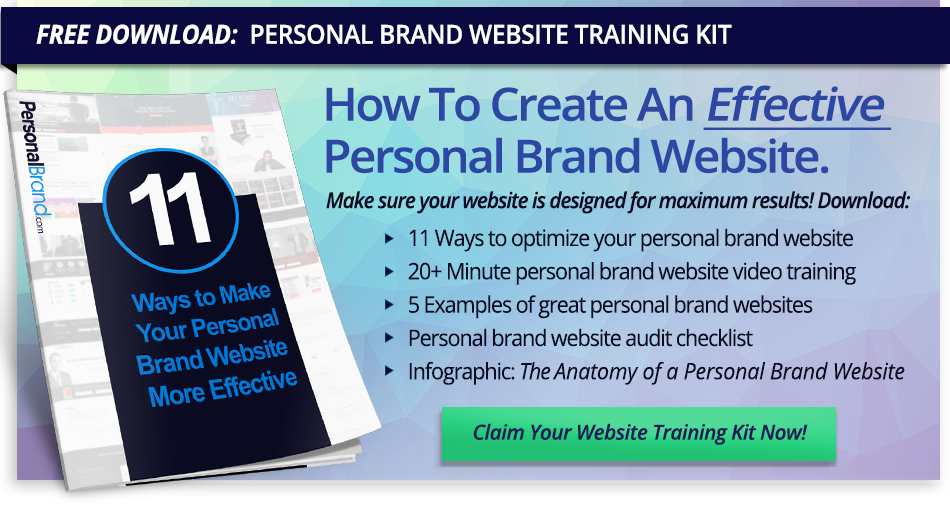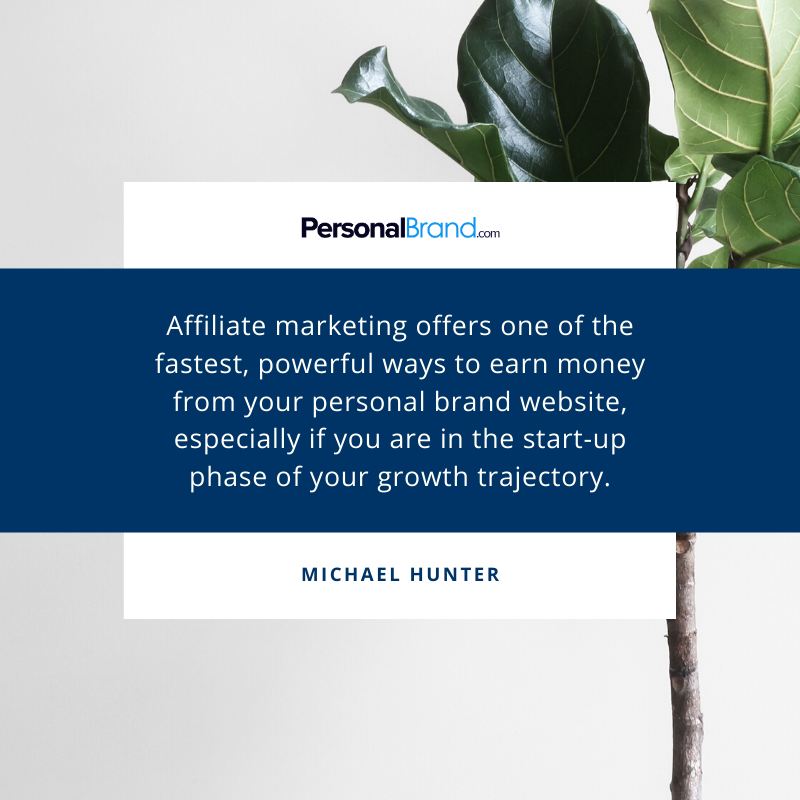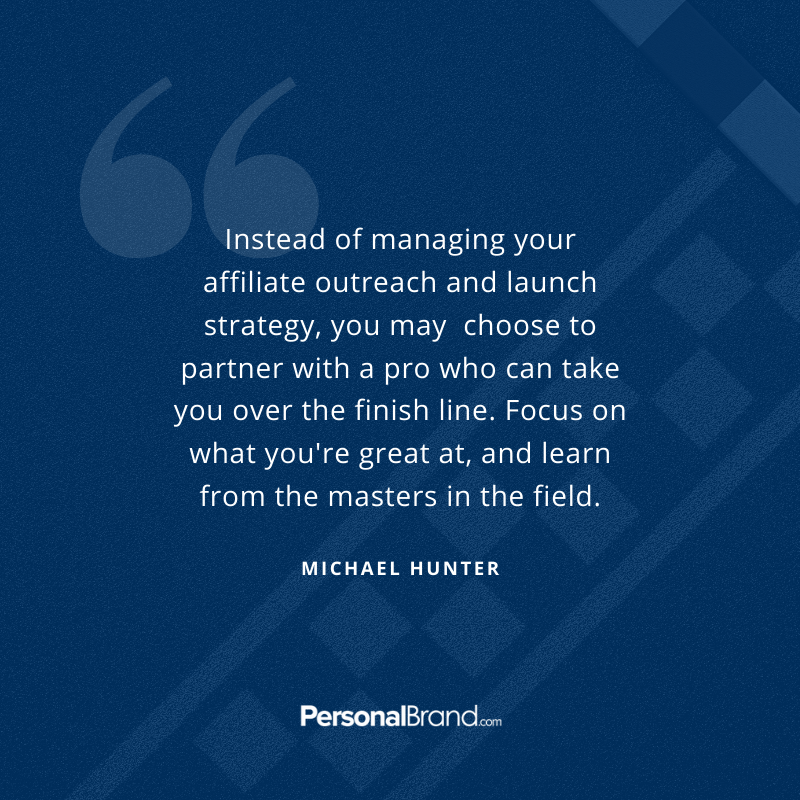The 9 Expert Tips to Boost Sales with your Personal Brand Website
Being an entrepreneur means you get to accomplish a goal that many people would love to achieve if they only knew how—monetizing your passion. Your personal brand website should be the cornerstone of your marketing and revenue generation strategy, but to start earning sales, you’ll need to execute a multi-faceted approach that offers you diverse potential income streams.
To help you get started making money with your personal brand website, we’ve compiled a list of nine expert tips.
1. Affiliate Marketing
Affiliate marketing is a strategy that allows you to build strategic alignments with brand partners while earning passive income. In an affiliate marketing program, you promote products from other brands that are related to but do not compete with your brand or services. If a visitor to your website purchases a partner product, you earn a commission.
Affiliate marketing offers one of the fastest and most common ways to earn money from your personal brand website.
If you are still in the start-up phase of your growth trajectory and aren’t yet fully established with your online product or service sales model, especially so.
How to Get Started:
Identify partner brands that share your target audience and whose products complement your personal brand. For example, if you are a fitness coach and sell 60-day fitness training programs, you could partner with a preferred supplement brand or fitness apparel line.
If you are an executive time management coach, you could partner with a project management software company or an organizational app.
Once you have your list of target brands, reach out and ask if they would be interested in advertising on your personal brand website. Typical commission rates range from 30 to 70 percent of the product or service price, depending on the strength of your network and how much value you bring by aligning your personal brand with the product partner.
Bonus Ninja Tip:
Instead of managing your outreach strategy, if budget allows, you may also choose to partner with an affiliate marketing network, such as CJ Affiliate. The benefit that these established networks offer is that they come with extensive lists of existing brand partners, allowing you to outsource the outreach and negotiation aspects of your affiliate networking strategy.
Affiliate marketing companies can also assist with execution and analytics, so you have time to focus on what you do best—growing your personal brand.
2. Pay Per Click (PPC) Contextual Ad Networks
The PPC Ad Network takes a slightly altered approach to the affiliate network. In this strategy, you still place partner ads on your personal brand website, but here you get paid every time someone clicks on one of the advertisements, regardless of whether they make a purchase (we know, right?!).
The downside to PPC ads is that the payout is typically much smaller than that of an affiliate ad.
You bring the most value to your partners by supplying a high volume of traffic to view their products, which means the more website visitors you have, the more you stand to earn.
It also means that if you are just getting started building your network, you may not see significant payouts until you grow your personal brand awareness more significantly. These engagement hacks will help if you’re still in the growth phase.
How to Get Started
Partner with a contextual ad network, like Google AdSense. Once your account set-up is complete, you’ll be able to copy and paste snippets of code into the backend of your website so that your trackable, money-making partner ads appear as desired. The benefit of working with an established and broadly used service like Google AdSense is that the service will identify ideal ads for your website based on your personal brand website content, helping take the burden off you to identify valuable product alignments.
Bonus Nina Tip:
Click here for deep insights on choosing the right ad network to grow your personal brand.
3. CPM Advertising Networks
Taking the paid advertising placement strategy yet one step further, there are advertising networks you can purchase that will allow you to place relevant third-party ads on your website, which pay you not when someone buys or clicks, but when someone simply views the advertisement. The payment rate is typically a set dollar amount per thousand page views (in fact that’s where the term “CPM” stands for —”cost per thousand.”)
The caveat here, however, is that, as the name implies, your personal brand website will only be an eligible advertising partner if you can guarantee significant site traffic
How to Get Started:
If you already have the required website traffic to monetize ad views, begin by choosing a CPM network, such as Amazon Associates, Conversant, or Exponential Interactive.
4. Sell Advertising
Once your personal brand has gained traction, and you have a significant network of followers and are seeing steady traffic to your website every day, you can sell advertising space on your personal brand website.
When your personal brand is established, relevant entities will be willing to pay you to allow their products to appear on your website and in front of your raving fans.
Again, this is a strategy that is only effectively employed after you have reached a certain threshold of success with your personal brand.
How to Get Started:
If you’re considering selling ads on your website, then you should already have a network of established partners or products you’d be willing to endorse. Approach them directly to inquire about advertising options. Just make sure you’re prepared to answer questions about placement and cost. If you work with a marketing team to manage your website, allow them to do what they do best and strategize advertising alignments for you.
5. Sell Thought-Leader Content
You could no doubt write a book about your area of expertise—so do it and sell it on your personal brand website. To offer a paid educational download, you don’t need to get published by one a global publishing house. All you need to do is self-publish an insightful eBook with valuable content.
The production requirements will include your time to write the content and the assistance of a proofreader and designer to help you produce a final downloadable PDF that is worth a small sum for access.
The value of offering paid educational content extends beyond revenue generation potential. Purchasable thought leader content also serves as a bottom of the funnel lead generation tactic.
A prospect who comes to your website and is interested enough in what you have to say that they will pay $5 – $20 for an eBook that you’ve authored is someone you should continue to prospect as a potential buyer of your primary products and services.
Make sure your eBook download strategy involves a web form that not only accepts a secure payment transaction, but that also saves the buyer’s name and email address in your prospecting database so you can follow up with him or her with future sales correspondence. For more tips on building your email database, review these email list accelerators.
How to Get Started
No surprise here, you’ll need to write a book before you can sell it. Make sure you are writing about a topic of interest for prospective customers, but don’t give away all your best secrets. You should be getting paid what you’re worth for your expert insights, but you can still aggregate some tips and best practices worthy of purchase to tease your broader offering.
Bonus Ninja Tip
If the idea of sitting down to write an eBook sounds like about as much fun as a life without Netflix, then consider monetizing more dynamic content instead, such as an on-demand webinar training series.
6. Sell Subscription Content
Subscriber marketing is another more advanced revenue generation strategy best employed by personal brand leaders with broad existing membership bases and lots of monetizable content. To execute, allow fans to pay a recurring monthly or annual fee for unlimited access to your most valuable library of content, such as training videos, tutorials, webinars, white paper, checklists, guides, and eBooks.
Determining the material that you will gate and how much you charge are critical strategic choices that will significantly impact the success of your strategy.
How to Get Started
Review these six reasons why subscriptions are essential to building a personal brand, and then learn how to increase your subscriptions.
7. Accept Donations
If you are still in the process of growing your community and your library of content, politely invite viewers to donate to your website. Even Wikipedia leverages this tactic. Adding a donate button to your personal brand website is a small step, but it can help you earn passive income in your early start-up phase.
How to Get Started
Consider partnering with a trusted and familiar payment gateway, such as PayPal, to allow visitors to make a secure donation to your website. PayPal makes it easy to integrate their recognizable branded donate buttons to your website, once you establish a PayPal business account. If you already have a PayPal account, click here to get started creating your donate button.
8. Offer to Write Sponsored Posts
As a leader in your space, people want to know your opinion on the value of industry-related products and services. As a result, brands will be willing to pay you to review their product or offering (hopefully, favorably). Writing sponsored posts allows you to get paid for blogging on your personal brand website, something you are likely already doing.
Brands are often willing to pay anywhere from a few hundred dollars to a few thousand dollars for a favorable post about their product, depending on your notoriety and your website traffic levels.
How to Get Started
Contact brands you endorse and ask if they would consider a sponsored post partnership. It is vital that you approach brands you can honestly write about favorably to ensure you are retaining your credibility with your audience of followers. To further ensure transparency and authenticity, clearly state on your website when a blog is sponsored.
9. Sell Your Products and Services Directly Through Your Personal Brand Website
If you’re not already doing so, you’ll want to put a strategic plan in place to allow prospects to purchase your products and services directly through your website. No matter your industry or offering, in the era of digital proliferation, every personal brand needs a way to enable anytime, anywhere, device-agnostic (think desktop or mobile) online transactions.
For example, if you’re a life coach, you should be allowing prospects to sign up for pre-set classes or coaching sessions from your personal brand website. If you’re an author and motivational speaker, you should let a prospect begin the process of booking you to speak at their event. If you’ve developed software, you should enable prospects to schedule a demonstration, initiate a free trial, and ultimately purchase a subscription, all from your personal brand website.
How to Get Started
You’ll need a trusted and secure payment form software solution, and a strategy to generate revenue by optimizing traffic, conversions, and upsells, which we cover in this article by our sister company, Spiffy.
Final Words of Advice
Don’t make the mistake of reading this list and thinking you need to choose just one of these approaches to make money from your personal brand website.
Try them all to determine which makes the most sense for your personal brand, your audience, your position in your growth phase, and your revenue goals.
Just make sure you’re always getting paid what you’re worth. An experienced expert like you deserves to be compensated for his/her knowledge—no matter its format or delivery channel.
We hope you enjoyed this article, thanks for reading! Also, follow us on Facebook, and Twitter for updates every time we publish!





